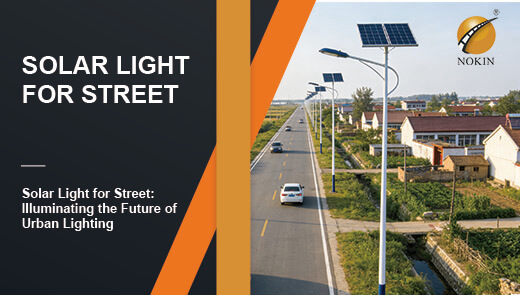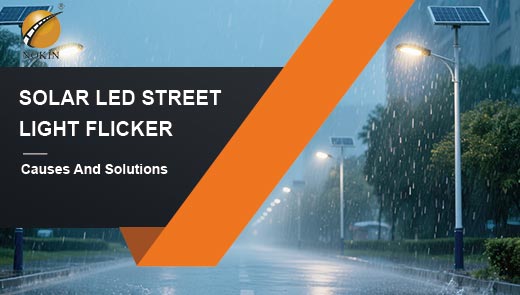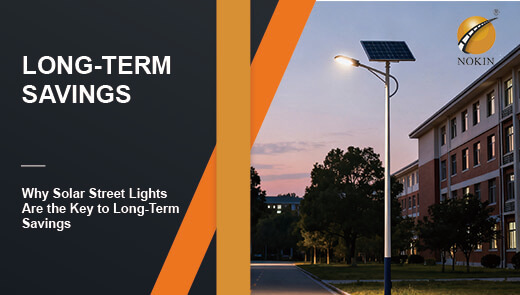Why do Solar Street Lights Gradually Dim
When the night falls, the solar street light that should bring light to people gradually fades away, and the brightness decay problem of solar street light is becoming a hidden pain point in the field of urban lighting. Data show that 68% of the solar street light systems used for more than 2 years have different degrees of brightness decline, and 15% of the lamps and lanterns have even lost their basic lighting function due to serious degradation. This phenomenon is a direct threat to the safety of pedestrians and vehicles at night. What's even more concerning is that the majority of users' perception of brightness degradation remains at the surface level of "dead batteries", and the lack of diagnostic capabilities for systematic failures leads to high maintenance costs but little results. Nokin will start from the principle of equipment, build a full chain solution from fault diagnosis to long-term maintenance, and provide professional guidance for the efficient operation of solar street lights.
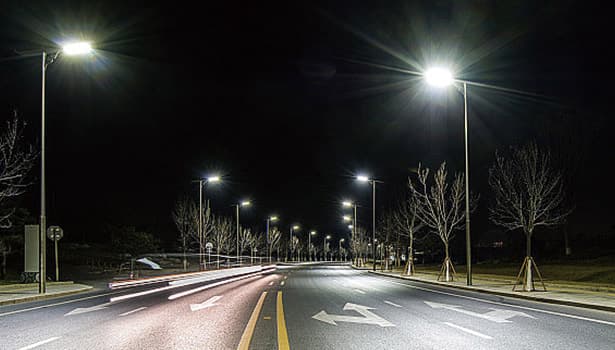
Explanation of the Cause of Dimming of Solar Street Light
Battery of Solar Street Light Lighting System Fails
As the energy center of solar street light, the performance decay of rechargeable battery is the most common factor leading to the brightness decline. The mainstream energy storage solutions currently on the market include valve-regulated lead-acid batteries, lithium ternary batteries and lithium iron phosphate batteries, and regardless of the type, there is a physical upper limit to their charge/discharge cycle life.
Battery failure is typically characterized by a continuous decline in capacity. When the battery capacity decreases to less than 70% of the rated value, the power supply capacity at night will be significantly reduced, and the brightness of street lights will then show a stepwise decline. More seriously, if the failed battery is not replaced in time, electrolyte leakage may occur. Once the battery acid touches the circuit board, it will quickly corrode the copper foil lines and electronic components, causing irreversible hardware damage.
Hidden Constraints of Insufficient Light
The energy of solar street lights comes from the capture of sunlight by photovoltaic panels, and the advantages and disadvantages of lighting conditions directly determine the energy input of the system. Research shows that most solar streetlights need more than 6 hours of effective sunlight per day to meet the nighttime lighting requirements, where "effective sunlight" refers to the length of sunlight with light intensity ≥ 20000lux. In actual operation, insufficient light may be caused by a variety of factors:
Ambient shading
The sunlight received by the PV panels may be lower than the critical value due to overgrown street trees in urban greenery, shadows from newly constructed buildings, or even deviations in the mounting angle of the street lights themselves. It is important to note that solar panels do not need to be in direct sunlight all day, but they must be free of significant shading during the main sunlight hours of 9 am to 4 pm.
Seasonal light variations
During winter in the northern hemisphere, the sun's altitude angle decreases, and the natural law of shorter days and longer nights shortens the effective exposure time of photovoltaic panels by about 30%, which makes it easier for the brightness to be significantly lower in winter than in summer if system configurations (e.g., increased battery capacity) are not adjusted accordingly. In addition, the extreme night phenomenon in high latitude areas and the light attenuation in haze-prone areas pose special challenges to the energy supply of solar street lights.
Dirty Solar Panels
The cleanliness of the surface of a solar panel is directly and positively related to the energy conversion efficiency. Even a thin layer of dust, which is imperceptible to the naked eye, can have a significant impact on light absorption. Experimental data show that a 0.1mm thick layer of dust can reduce the efficiency of PV panels by 15-20%, and in industrial dusty areas or coastal salt spray areas, the loss of efficiency can exceed 30% if the panels have not been cleaned for 3 consecutive months.
Silicate particles from urban road dust, sulfides from industrial emissions, and organic matter from bird droppings can form a composite layer of pollutants on the panel surface, where the organic matter will undergo a photochemical reaction under sunlight, forming stubborn stains that are more difficult to remove. Improper cleaning will also affect the performance of PV panels. Some maintenance personnel use high-pressure water gun to rinse the panel directly, this method can quickly remove the stains, but may lead to panel edge sealing tape loosening, and even in the glass surface to produce micro-cracks, for the subsequent rainwater infiltration buried hidden trouble. The correct cleaning should use a soft fiber cloth with a neutral cleaner to avoid physical damage to the panel.
Solar Panel Damage
As the core component of energy conversion, the failure of PV panels can lead to the collapse of the overall system performance. Common causes of PV panel damage include: natural disaster impacts such as hail, mechanical stress damage during installation, and aging of the encapsulation film due to long-term UV exposure. Failure characteristics are more intuitive when there are obvious cracks in the PV panels or when the glass is broken, but more often than not, hidden internal damage needs to be detected by professional means.
LED Light Source Failure
The failure of LED light source may be manifested in a variety of forms, such as no light at all, flickering or localized dark areas. Among them, light failure is the main reason for the gradual decline in brightness. Poor quality LED chip light failure rate of up to 30% per year, while high-quality chips in normal operating conditions, the light failure rate can be controlled within 5% per year. In addition to the quality of the chip, heat dissipation design defects is an important factor in accelerating the light failure. When the LED junction temperature exceeds 80 ℃, the light decay rate will be exponential growth, which is the reason why many solar street lamps have a significant decrease in brightness during the summer high temperature.
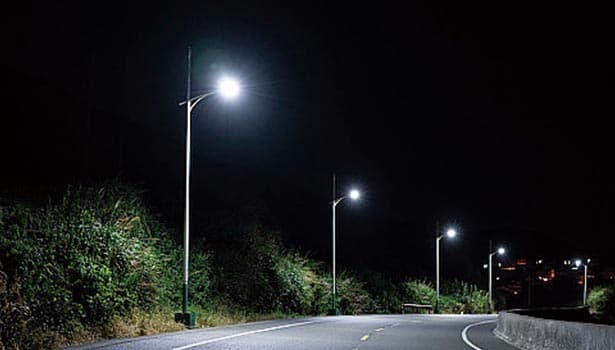
Hidden Faults in Circuit Connection
Reversed polarity
When the positive and negative poles of the solar panel are reversed, the system may work normally when the battery is fully charged, but once the battery is depleted, the anti-reverse connection diode in the controller will burn out due to the prolonged reverse energization, resulting in a permanent failure of the system. This type of failure is typically characterized by "normal initial installation, not working after long time" and accounts for about 8% of maintenance cases.
Cable problems
UV rays and rain erosion in the outdoor environment will gradually crack the outer skin of the cable, oxidizing and corroding the metal terminals, and the contact resistance will then increase. When the contact resistance exceeds 0.5Ω, the voltage drop in the circuit will lead to insufficient voltage at both ends of the LED, manifesting as reduced brightness or flickering. In coastal areas, salt spray corrosion will accelerate this process, it is recommended to preventive replacement of the cable every 1-2 years.
Control System Parameter Errors
Default factory settings
The default factory settings may not be able to adapt to the specific installation environment, for example, the default value of light control sensitivity of a certain controller model is 20lux, in urban areas with serious light pollution, the ambient luminance at night may be higher than this threshold for a long period of time, which leads to the street light not being able to turn on normally. As for the time control settings, if the switching time is not adjusted according to seasonal changes, the phenomenon of "lights still on at dawn" or "lights not on in the dark" will occur, which not only wastes energy but also shortens the battery life.
Hardware failure of controller
When the controller has parameter drift under high temperature environment due to capacitor quality problem, it will cause solar street light to go out early in the second half of the night. This kind of failure needs to be diagnosed by waveform analysis with professional equipment. With the development of technology, intelligent controllers with MPPT (Maximum Power Point Tracking) function are gradually popularized, and its energy utilization rate can be increased by 15%-20% compared with the traditional PWM controller, but at the same time, it also puts forward higher requirements on the professionalism of parameter setting.
Solar Street Lights Systematic Maintenance Strategy
Photovoltaic Panel Maintenance Procedures
Daily Cleaning Practice
Daily cleaning of solar panels should follow the principle of "gentle cleaning and coating protection". It is recommended to use neutral detergent with pH value of 7-8, together with soft chamois leather cloth or sponge for wiping.
Cleaning frequency should be determined according to the installation environment. Ordinary urban roads are recommended to be cleaned once a quarter; industrial dust areas, coastal areas or heavily polluted areas should be cleaned once a month; in dust storms, heavy rain and other extreme weather, additional cleaning needs to be carried out in a timely manner. In a highway lighting project, after shortening the cleaning cycle from half a year to quarterly, the brightness stability of the system was improved by 40% and the battery life was extended by about 1 year.
Structural maintenance points
In addition to surface cleaning, structural maintenance of PV panels is equally important. The fastening of the mounting brackets should be checked every six months, and the bolts should be tightened to the specified torque (usually 8-10N・m) with a torque wrench to prevent loosening of the mounting due to wind and vibration. At the same time, the tilt angle of the PV panels should be adjusted to match the local latitude: in general, the optimal tilt angle is approximately equal to the local latitude, with a deviation of no more than 5° from north to south. In the northern hemisphere, the solar panels are oriented due south to obtain the maximum amount of sunlight, but in the special case of shading, an azimuthal deviation of up to 15° is permissible.
For solar panels that have been in use for more than 5 years, it is recommended that regular electrical performance tests be conducted to measure the short-circuit current and open-circuit voltage using a PV-specific tester, and to compare them with the factory data, and when the efficiency decreases by more than 20%, an overall replacement should be considered. It is worth noting that the attenuation rate of solar panels is faster in the first 2 years of use, after which it will tend to stabilize, and high-quality products can still maintain more than 80% efficiency after 10 years.
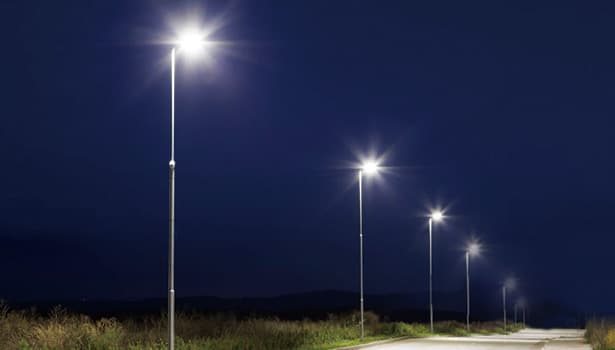
LED Light Source Maintenance
Anti light decay technical measures
Selection of high-quality LEDs is the basis for slowing down light degradation. In the chip selection, should prioritize the use of gold wire package products, its conductivity and reliability is far better than the cheap copper wire package. At the same time, the luminous efficiency parameters of the LED (lm/W) should not be less than 150, the color temperature is recommended to choose 4000K-5000K warm white, this color temperature not only ensures sufficient visibility, but also has a better penetration of rain and fog.
Heat dissipation system optimization
Good heat dissipation design is the key to prolong the life of LED. In the design of solar street light structure, it should ensure good heat conduction between LED substrate and heat dissipation fins, and it is recommended to use silicone grease with thermal conductivity ≥1.5W/(m・K) to fill in. Regularly check whether the heat dissipation fins are dusty or not, use compressed air to blow away the dust in the gap to keep the air convection channel smooth.
Light source replacement strategy
When the LED brightness drops to 70% of its initial value, it is recommended to replace the entire LED. This threshold is based on the human eye's perception of changes in brightness: when the brightness drops by 30%, most people will clearly notice the lack of lighting. When replacing the light source, attention should be paid to the matching of the photoelectric parameters of the old and new LEDs, especially the color temperature deviation should be controlled within ±200K, so as to avoid obvious color difference. For solar streetlights with modular design, LED modules can be replaced individually to reduce maintenance cost.
Intelligent Maintenance Program
Remote monitoring system deployment
With the development of IoT technology, installing remote monitoring module has become an important means to improve maintenance efficiency. GPRS or NB-IoT communication module can collect key parameters such as battery voltage, PV panel current, environment temperature and so on in real time, and analyze the data through the cloud platform. When the system is abnormal (e.g. battery voltage is lower than 10.5V, PV panel current is 0), the platform will automatically send an alarm message to the maintenance personnel's cell phone, realizing early warning of failure.
Preventive maintenance program
Establishing a preventive maintenance program based on the life of components can effectively avoid sudden failures. According to the experience of the industry, the recommended replacement cycles of the main components of solar street lights are as follows: 2-3 years for storage battery (depending on the usage environment), 3-5 years for LED light source, 3-4 years for controller, and 5 years for cables.
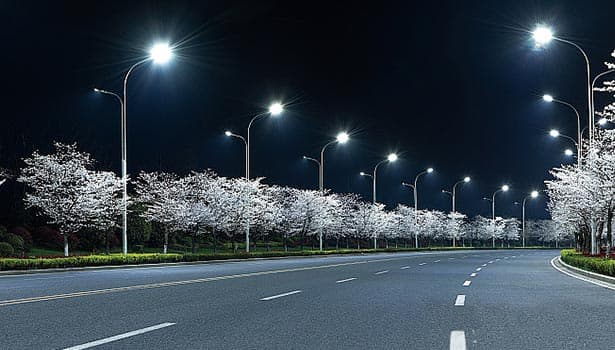
Purchasing Mistakes of Solar Street Lights
Solar Panel Performance Selection
The conversion efficiency of solar panels is the primary consideration. The conversion efficiency of monocrystalline silicon solar panels can reach 18%-22%, which has obvious advantages over polycrystalline silicon (15%-18%) and amorphous silicon (10%-13%) under the same light conditions. For areas with limited light conditions, priority should be given to monocrystalline silicon panels to maximize energy acquisition. It is also important to ensure that the panels are weatherproof and work well in temperatures ranging from - 40°C to + 85°C.
Battery System Configuration
The configuration of the battery capacity takes into account the duration of lighting, local sunlight conditions and the number of consecutive cloudy and rainy days. Calculation formula:
Battery capacity (Ah) = Load power (W) × Lighting time (h) × Safety coefficient (1.5-2.0) ÷ Battery operating voltage (V)
For example, 10W LED solar street lamps are illuminated for 10 hours a day, and required to work normally for 3 consecutive days of cloudy and rainy weather, the capacity of 12V batteries is calculated as 10 × 10 × 2 ÷ 12 ≈ 16.7Ah, and the capacity of more than 20Ah should be selected. The actual capacity should be more than 20Ah.
In the choice of battery type, it is recommended to use lithium-iron batteries in cold areas, whose operating temperature range can reach - 40 ℃ to + 60 ℃, while high temperature and hot and humid areas can use more cost-effective lithium ternary batteries.
LED Optical Parameters
The luminous efficacy of LED (lm/W) directly determines the energy utilization rate, should choose ≥ 150lm/W products. The choice of luminous flux should be determined according to the installation height of the solar street light and road width: 6 meters high recommended luminous flux 1500-2000lm, 8 meters high recommended 2500-3000lm. color temperature, urban roads should choose 4000K-5000K warm white light, which not only reduces light pollution, but also improves the recognition of pedestrians and vehicles.
Waterproof and Dustproof Grade
The waterproof and dustproof grade of the solar street light should be not less than IP65, of which "6" means completely preventing dust intrusion and "5" means preventing low-pressure water spray. Special attention should be paid to the sealing parts such as junction box and controller compartment, which should be sealed with silicone rubber sealing ring and double-fixed by clips or screws. In coastal areas or humid environments, an IP66 rating is recommended to protect against heavy rainfall.
Cleaning Technology Applications
Solar panels with self-cleaning features can significantly reduce maintenance costs. Currently, the mainstream self-cleaning technologies include TiO2 nano-coatings, which utilize photocatalysis to break down organic pollutants, and superhydrophobic coatings, which use the microstructure of the surface to make water droplets form into beads that carry away dust. Test data shows that self-cleaning coatings can extend the cleaning cycle of panels by 2-3 times, which is especially effective in rainy areas.
Intelligent dimming function
Solar street lights with intelligent dimming function can automatically adjust the brightness according to the environmental needs, which can ensure the lighting effect and extend the life time. Common dimming modes include: 100% brightness in the whole night, 100% in the first half of the night and 50% in the second half of the night, and mixed mode of light control and time control. Choosing a controller with MPPT function can track the maximum power point of solar panels in real time, which improves the energy utilization more obviously in cloudy weather or insufficient light.
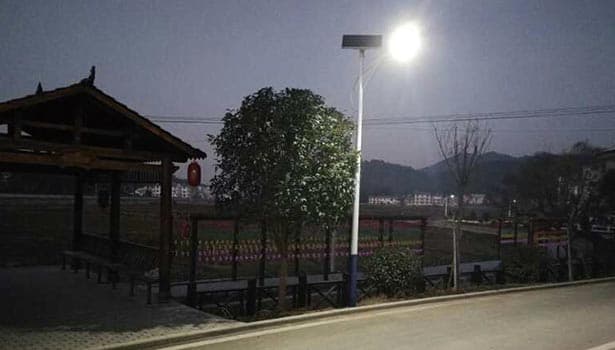
Conclusion
The dim problem of solar street lights is essentially a systematic engineering challenge involving energy conversion, storage, and application. From battery chemistry to photovoltaic devices, from environmental factors to human maintenance, small deviations in each link may accumulate into significant performance degradation in long-term operation. Through the troubleshooting methods, maintenance strategies and purchase guidelines described in this paper, we can establish a set of scientific management system to control the brightness degradation in an acceptable range, so that the solar street lamps can truly realize the green lighting concept of "one-time investment, long-term benefits".

